#caprifoliaceae
Explore tagged Tumblr posts
Text



Caprifoglio (Lonicera caprifoliumL., Caprifoliaceae)
300 notes
·
View notes
Text
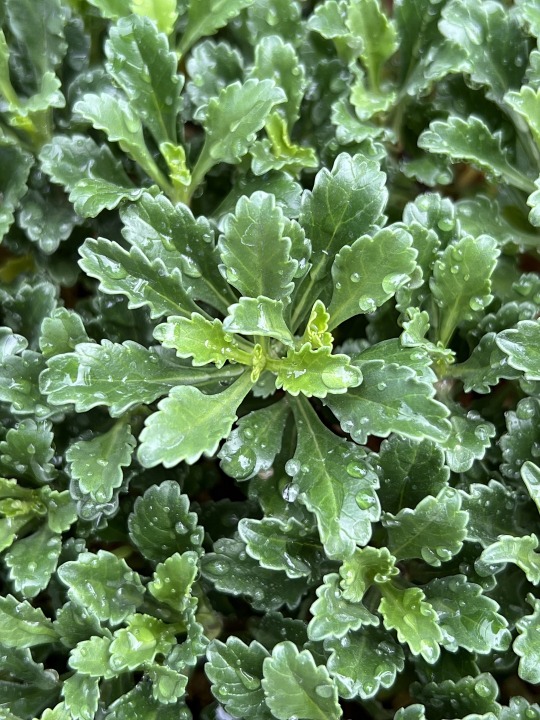

Scabiosa farinosa
This delightful little Scabiosa forms neat cushions of shiny green foliage, with added interest provided by the scalloped leaf edges. The flower clusters are creamy white at the center, and tinged with pale purple at the outside. A great rock garden plant! From Tunisia and adjacent northeastern Algeria. Scabiosa belongs to the family Caprifoliaceae (the Honeysuckle Family).
-Brian
17 notes
·
View notes
Text

Abelia chinensis / Chinese Abelia at the JC Raulston Arboretum at North Carolina State University in Raleigh, NC
#Abelia chinensis#Abelia#Caprifoliaceae#Chinese Abelia#Plants#Flowers#Nature photography#photography#photographers on tumblr#Jc raulston arboretum#north carolina state university#Ncsu#Raleigh#Raleigh NC#north carolina#🌺🌻
7 notes
·
View notes
Photo

Twinflower Linnaea borealis Caprifoliaceae
Photograph taken on June 18, 2023, at Purdon Conservation Area, Lanark Highlands, Ontario, Canada.
#wildflowers of southern ontario#Twinflower#Linnaea borealis#Caprifoliaceae#Linnaea#pink#white#Purdon Conservation Area#Purdon#Lanark Highlands#Ontario#Canada#wildflowers#wildflower#flora
26 notes
·
View notes
Photo
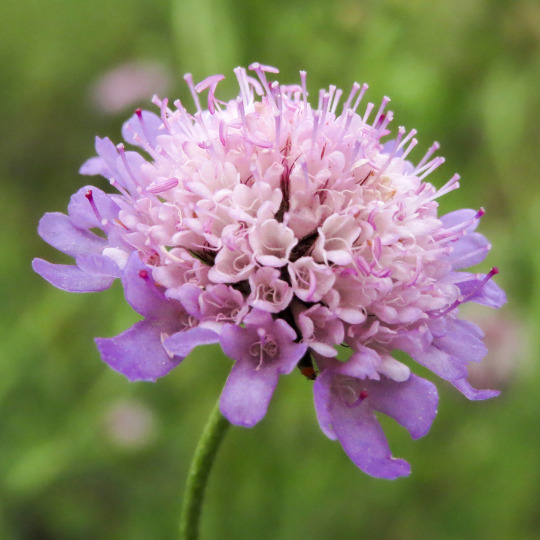
Scientific Name: Scabiosa atropurpurea, syn. Sixalix atropurpurea Common Name(s): Sweet scabious, pincushion flower, mourningbride Family: Caprifoliaceae (honeysuckle) Life Cycle: Annual, perennial Leaf Retention: Deciduous if perennial Habit: Forb USDA L48 Native Status: Introduced Location: Plano, Texas Season(s): Spring
On iNaturalist, there are 12 species listed under the genus Sixalix and another 50 or so under Scabiosa, but it’s not at all clear to me why they’ve been separated. Plants of the World Online (POWO), which iNaturalist uses as its taxon authority, regards Sixalix as a synonym for Scabiosa, and a search for Sixalix in the U.S. government’s Integrated Taxonomic Information System (ITIS) yields no results (i.e., it doesn’t even exist in ITIS). It seems to me that all the Sixalix species should be moved under Scabiosa, but what do I know.
The USDA PLANTS database shows this plant as a perennial, but from what I’ve been able to gather, that’s only under the most favorable growing conditions. Even then, it’s a short-lived perennial (perhaps 3 years or so), and it’s an annual otherwise.
#Scabiosa atropurpurea#Sixalix atropurpurea#sweet scabious#pincushion flower#mourningbride#Caprifoliaceae#annual#perennial#deciduous#forb#introduced#Plano#Texas#spring#flower#purple#iNaturalist#taxonomic confusion#plantblr
22 notes
·
View notes
Text
Language of Flowers: Teasel
In the language of flowers, every day has its designated flower. The flower for today, December 2, is Teasel, which signifies misanthropy. Image above from Wikipedia. Dipsacus is a genus of flowering plant in the family Caprifoliaceae native to Europe, Asia, and northern Africa. The genus name is derived from the Greek word for thirst (dipsa) and refers to the cup-like formation made by Teasel…
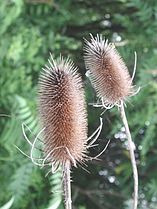
View On WordPress
#birthday#Caprifoliaceae#December#Dipsacus#dipsacus saponin C#Francis Darwin#herbalism#Language of flowers#Teasel
2 notes
·
View notes
Text
#1949 - Viburnum plicatum - Japanese Snowball Bush

A 3m tall shrub in the Adoxaceae (formerly Caprifoliaceae), native to China, Korea, Japan, and Taiwan. The Latin plicatum means “pleated”, referring to the texture of the leaves.
You might wonder, from this photo by @purrdence, why this plant is called the Snowball Bush. Snowballs aren’t usually this colour unless there’s been a horrible accident with a snowplow (I’m looking at you, George Lazenby).
The reason, of course, is that this is the fruit (later in the season the fruit turns black). The flowers, on the other hand, form compact white masses, with a central cluster of fertile yellowish-white flowers 5mm diameter, surrounded by a ring of showy, sterile flowers 2–3 cm diameter as a target for passing pollinators. A lot of the cultivars try to maximise the number and size of the sterile flowers. Unsuprisingly one of those cultivars is called ‘Popcorn’.
4 notes
·
View notes
Text

#IFTTT#Flickr#honeysuckle#lonicera#caprifoliaceae#whitecyclamen#pink#flowers#yellow#buds#outdoors#day#colour#horizontal#nikond7000#magdaindigo
0 notes
Text






L – Lonicera xylosteum L. – Caprifoglio peloso (Caprifoliaceae)
Bombus pascuorum (Scopoli, 1763)
#photographers on tumblr#digital image processing#original photographs#flowers#Bombus#pollination#fruits#Caprifoliaceae
9 notes
·
View notes
Text

藪空木[Yabuutsugi] Weigela floribunda
藪[Yabu] : Thicket, bush
空木[Utsugi] : Deutzia
空木 means 空ろな木[Utsuro na ki], that is, tree with hollow stems. Even with this name, there are different species. For example, Utsugi(Deutzia crenata) is in the family Ajisai(Hydrangea, Hydrangeaceae), Kogomeutsugi(Neillia incisa) is in the family Bara(Rose, Rosaceae), and Yabuutsugi is in the family Suikazura(Honeysuckle, Caprifoliaceae).
A closely related species is Hakoneutsugi(Weigela coraeensis), which is similar. The way to tell them apart, its flowers are white at the time of flowering and gradually turn reddish, and its calyx tube is suddenly thickened from the middle. On the other hand, the flowers of Yabuutsugi are reddish from the time of flowering, and the calyx tube is gently thickened.
14 notes
·
View notes
Text

Patrinia scabiosifolia / Eastern Valerian at the Sarah P. Duke Gardens at Duke University in Durham, NC
#Patrinia scabiosifolia#Patrinia#Caprifoliaceae#Eastern Valerian#Golden lace#Plants#Flowers#Nature photography#photography#photographers on tumblr#Sarah P. Duke Gardens#Duke Gardens#Duke University#Durham#Durham NC#North Carolina#🌺🌻
9 notes
·
View notes
Photo


Twinflower Linnaea borealis Caprifoliaceae Family
Photographs taken on June 20, 2023, at Petroglyphs Provincial Park, Woodview, Ontario, Canada.
#wildflowers of southern ontario#twinflower#pink#wildflowers#wildflower#flowers#flower#Linnaea borealis#Linnaea#Caprifoliaceae#Petroglyphs Provincial Park#provincial park#canada#ontario#woodview#nature
22 notes
·
View notes
Text

Viburnum plicatum is a species of flowering plant in the family Adoxaceae (formerly Caprifoliaceae), native to mainland China, Korea, Japan, and Taiwan.
54 notes
·
View notes
Text
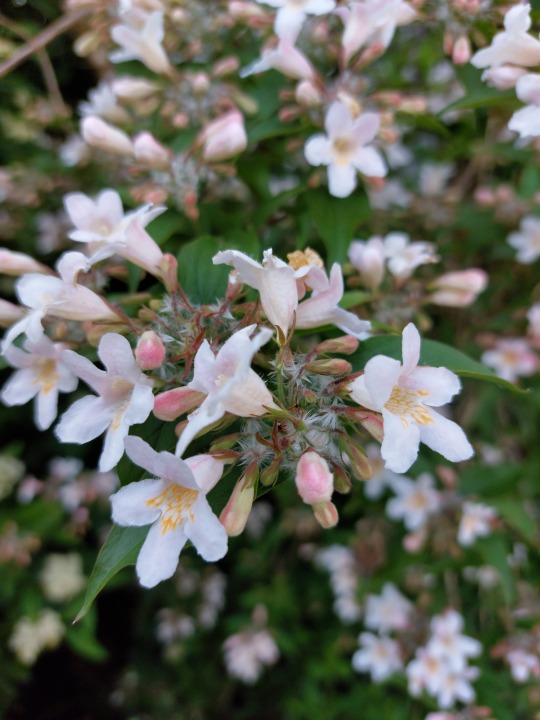

Sweet Emotion ;
Zabelia Tyaihyoni, Abelia mosanensis, the fragrant abelia, is a species of deciduous shrub in the honeysuckle family Caprifoliaceae.
24 notes
·
View notes
Text
#1944 - Leycesteria formosa - Himalayan Honeysuckle
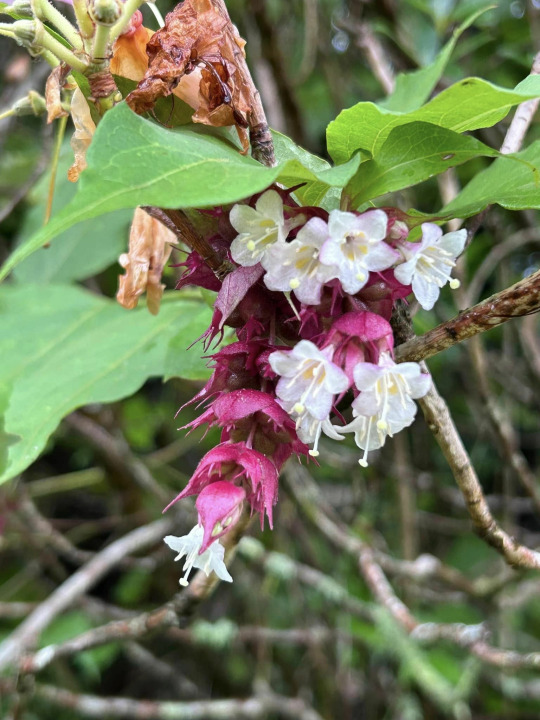
AKA, at least in English, as pheasant berry, pheasant-eye, spiderwort, whistle stick, granny's curls, partridge berry, chocolate berry, shrimp plant/flower, treacle tree/berry, flowering nutmeg, Himalaya nutmeg, Elisha's tears, Cape fuchsia, and Symphoricarpos rivularis. I’ll cover one of the local names in its home range below.
Those last few common names are particularly egregious nonsense - the plant is completely unrelated to nutmeg or to the fuchsia, and the entire family is unknown to Sub-Sharan Africa. And ‘Eilsha’s Tears is a corruption of Leycesteria. which was coined by the one-time director of Calcutta’s Royal Botanic Garden Nathaniel Wallich in honour of his friend William Leycester, a noted amateur horticulturist, in about 1820. ‘Formosa’ doesn’t help, since the plant doesn’t grow in Taiwan, and is simply the Latin for beautiful.
Native to Pakistan, India, Nepal, both East and West Himalaya, Southwestern China, Tibet and Myanmar. A noxious invasive species in New Zealand, Australia, the neighbouring islands of Micronesia, and elsewhere. The berries are unpleasantly bitter when unripe, and possibly poisonous if reports from Australia and New Zealand are confirmed, but once soft and deep purple-brown in colour are edible and sweet, having a mild flavour reminiscent of caramel or toffee.
The plant was first cultivated in the UK in 1824, although reports at the time were a little disappointed - expectations had been raised by a plate in Wallich's Plantae Asiaticae Rariores, and while they might not have had Photoshop back then they certainly had artists who were a bit heavy handed with the coloured inks. After that they discovered that it grows well in cool dappled shade, readily colonising walls and cliffs (and the trunks of treeferns in New Zealand), and providing excellent food for pheasants. It’s also surprisingly resistant to pollution.
Local people across the home range had a wide range of names and medical uses for the plant. In Standard Chinese one name is 鬼吹簫 (Guĭ chuī xiāo) meaning ‘ghost-blown flute'. That and Whistle Stick refer to the way the hollow branches sing eerily when wind blows across them, and one of the non-medical uses for the plant.
2 notes
·
View notes
Note
Howdy, not sure if this is the right kinda question, but...
Do you have favorite zoological scientific name? If so, which one and why?
this is such a fun question!!!! I love learning about scientific names and where they came from I wish I took Latin in school so I could just like know but when scientific names are based around a scientist for example it's really funny like I know there's a type of arachnid who's genus is literally called "oops" because another scientist already used the genera "oops" for another type of arachnid
it's not zoological but my favorite scientific name overall is Lonicera maackii which is Amur honeysuckle an invasive plant in the United States it's a HORRIBLE plant overtaking tons of natural areas disrupting habitats and even local fauna- because it's invasive it buds and fruits earlier than most native plants and as a result deer and birds will eat them and spread the seeds more which is great for them but makes deer populations skyrocket due to the overabundance of food (and lack of natural predators in most areas because of humans)
as for why? its... ok don't laugh.
so this was one of the first plants I learned about in my first Horticulture class and I had to memorize and know some facts about around 80ish plants for that first class so I made a lot of like memory games to keep it in my head
and for honeysuckle I made a jingle for the scientific name and the family name I remembered because it's the caprifoliaceae family capri- like Capri sun and folia sounded like fellatio to me (blowjobs) and it's honeySUCKLE you suck a caprisun and... you get the idea lmao
As for my favorite zoological name? it's a little tougher because I worked so long in animal education it was easier to learn common names to teach my kiddos so scientific name memorization was never something I put a lot of effort into for those classes (it was more about family names less genera/species names) but I'd have to say Rattus rattus the black or ship rat
I think it's funny when the genera and species name is the same and having a rat called Rattus rattus is so silly
like look at this little guy! that's a rattus!
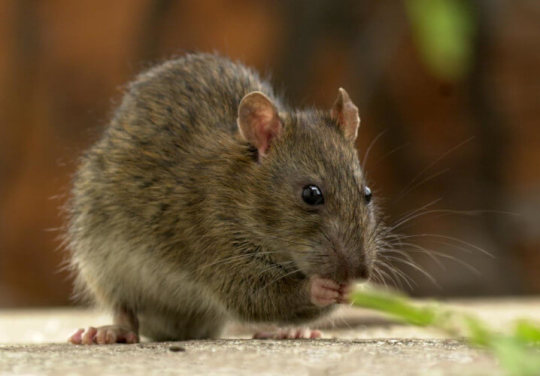
also while I was looking for a picture of a ship rat I found out there's a character called rattus rattus? apparently from horrible histories or something that's so silly
#horticulture#plant facts#invasive species#environmetalists#environmental science#zoology#rat#rats#scientific names#QnA
4 notes
·
View notes